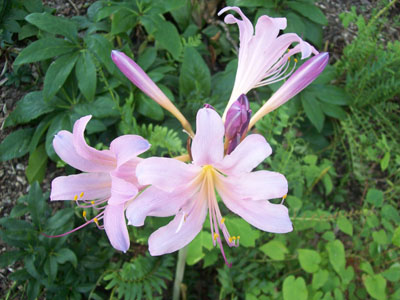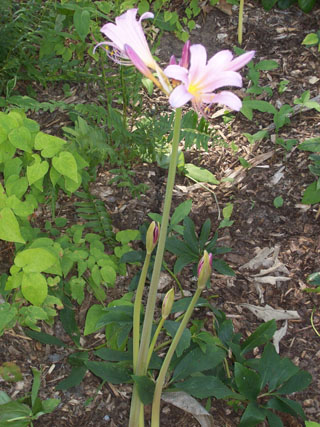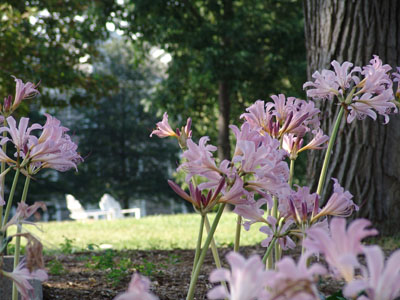Lycoris squamigera
A stroll along the Magill Walk in early August is bound to yield a pleasant surprise. Under the towering canopy of swamp white oaks, Quercus bicolor, bursts forth Lycoris squamigera. This event seems to happen overnight. The sudden emergence and explosion of bloom is reflected in several fun common names: surprise lily, resurrection lily, magic lily, and even naked ladies. The genus Lycoris is named for Marc Antony’s actress mistress.
A member of the Amaryllidaceae family, Lycoris squamigera, produces pink blooms bearing similarities to that of the common holiday amaryllis. The multitude of common names originates from the bulbs unique growth habit. In spring, the leaves sprout and grow, only to disappear as summer sets in. Then, in late July or early August, leafless flower stalks emerge. Emergence to flower occurs in the span of days. The 2 ft stems typically bear 6-8 flowers.
Lycoris squamigera is a welcome sight at the height of summer. The bulb is easy to grow, adapting to most soil types. Provide full sun to partial shade for maximum flower development. While there are other species, in various colors, Lycoris squamigera is the hardiest flourishing in zones 5-10. The bulbs have slender necks and should be planted a few inches below the soil surface, deeper in sandy soils or colder zones. The surprise lily is a triploid (having 3 sets of chromosomes instead of the normal two). The result, like that of the mule, is sterility. The triploid nature results in fast maturing bulbs that need division every three or so years. While summer’s heat drags both plants and people down, it is a sure harbinger of the beauty and enchantment that is the magic lily.








Dawnalee Bellis
Posted at 20:55h, 09 AugustI have these lilies in my yard all over.
What a surprise . Thanks for explaining what they are..
Becky Robert
Posted at 08:47h, 10 AugustThank you for checking out our info. We love the naked lilly and they are looking delightful all over campus right now.
Happy Gardening,
Becky Robert
Scott Arboretum